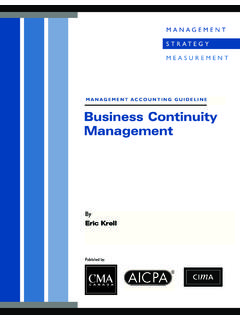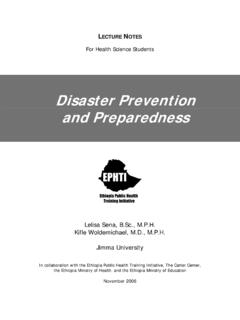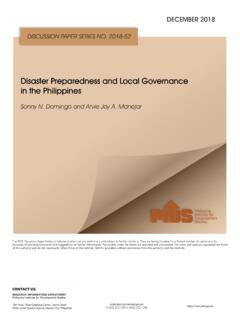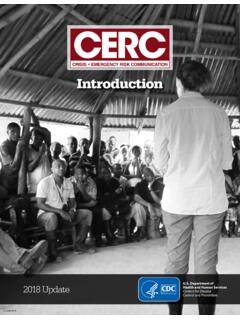Transcription of Community Based Vulnerability Assessment - MDC
1 Community Based Vulnerability Assessment A Guide to Engaging Communities in Understanding Social and Physical Vulnerability to Disasters Emergency Preparedness Demonstration Project March 2009. Emergency Demonstration Project Partners UNC Institute for the Environment 100 Miller Hall, CB #1105, Chapel Hill, NC 27599-1105. Phone: | Fax: Email: | MDC, Inc. PO Box 17268, Chapel Hill, NC 27516-7268. Phone: (919) 968-4531 | Fax: (919) 929-8557. Email: | Vulnerability Assessment : Step-By-Step Guidebook Acknowledgements This guidebook was made possible by a generous grant from the Federal Emergency Manage- ment Agency (FEMA). The grant funded the Emergency Preparedness Demonstration Project, from which this guidebook was developed. In particular, we would like to thank Ralph Swisher of FEMA for his support of this project and his dedication to emergency preparedness. We would also like to thank Susan Fowler, Bill Hoffman, and Barbara Wyckoff-Baird for their expertise and invaluable role as facilitators in the communities that participated in the demonstration.
2 Those communities included Chester County, Pennsylvania; Dorchester County, Maryland; Hampshire County, West Virginia; Hampton, Virginia; Hertford County, North Carolina; Washington, and Wilmington, Delaware. And a special thank you to the residents, government officials, nonprofit organizations, and faith- Based organizations who articulated the strengths, weaknesses, challenges and opportunities of their communities and brought their energy, opinions, and ideas to address the challenges of emergency preparedness, particularly for socially vulnerable populations. This project could not have occurred without your commitment. Our Community partners included: Chester County, PA. Chester County Department of Emergency Management Dorchester County, MD. Maryland Rural Development Corporation Dorchester County Department of Emergency Management Hampshire County, WV. Eastern West Virginia Community Action Agency, Inc.
3 Hampshire County Department of Emergency Management Hampton, VA. City of Hampton Neighborhood Office City of Hampton Department of Emergency Management Hertford County, NC. Roanoke Economic Development Inc. Hertford County Department of Emergency Management Washington, DC. DC Emergency Management Agency Wilmington, DE. West End Neighborhood House, Inc. City of Wilmington Department of Emergency Management Vulnerability Assessment : Step-By-Step Guidebook Table of Contents Overview ..1. How to Use this Guidebook ..6. Step 1: Getting Started ..9. Step 2: Identify and Rank Hazards .14. Step 3: Map Areas of Greatest Risk 17. Step 4: Identify and Map Physically Vulnerable People and Property ..23. Step 5: Identify and Map Socially Vulnerable Populations 31. Step 6: Identify and Map Employment Centers ..34. Step 7: Inventory and Map Environmental Hazards ..37. Step 8: Community Ground-truthing.
4 45. Step 9: Putting It Together ..48. Glossary ..52. Worksheets ..54. Appendix A: Citizen Participation ..65. Appendix B: Using Registries .66. Appendix C: Using Census Data ..67. Appendix D: Additional Resources ..69. Vulnerability Assessment : Step-By-Step Guidebook FIGURES. Figure 1: Key Steps in a Vulnerability Assessment ..6. Figure 2: How to Find Demographic Information (Block Group Level)..12. Figure 3: How to Find FEMA Maps Using the Interactive Mapping ..18. Figure 4: Sample FIRM Map of Wilmington, Delaware ..18. Figure 5: Sample GIS-generated Base Map of Wilmington, Delaware ..20. Figure 6: Sample Natural Hazards Map of Wilmington, Delaware ..21. Figure 7: Creating a Map Without GIS ..25. Figure 8: Sample Map of Critical Facilities for Wilmington, Delaware ..25. Figure 9: Sample Floodplain Map of Cambridge, Maryland ..27. Figure 10: Sample GoogleEarth Map of Cambridge, Maryland.
5 27. Figure 11: Sample Map of Critical Facilities for Wilmington, Delaware ..25. Figure 12: Hertford County Social Vulnerability Score Pop. Aged above 65 ..33. Figure 13: Sample Map of Employment Centers and Hazards Areas of Hertford County, North Carolina ..36. Figure 14: Sample Map of Environmental Threats in Wilmington, Delaware ..41. Figure 15: Final Checklist of Products for the Vulnerability Assessment ..51. TABLES. Table 1: Assessment Data and Outputs ..8. Table 2: Census 2000 Data Locations ..12. WORKSHEETS. Worksheet 1: Taskforce Membership ..54. Worksheet 2: Taskforce Contact Information ..55. Worksheet 3: Community Demographics Summary ..56. Worksheet 4: Inventory of Existing Information ..57. Worksheet 5: Identify Hazards ..58. Worksheet 6: Ranking Hazards ..59. Worksheet 7: Critical Facilities Inventory ..60. Worksheet 8: Current Inventory of People and Property.
6 61. Worksheet 9: Future Inventory of People and Property ..62. Worksheet 10: Employment Center ..63. Worksheet 11: Environmental Threat ..64. Vulnerability Assessment : Step-By-Step Guidebook OVERVIEW. introduction Every Community faces the risk of being struck by a disaster of one type or another, including natu- ral disasters such as floods, hurricanes, ice-storms, wildfires and earthquakes, or technological dis- asters such as a chemical spill or explosion. When disaster strikes, it can wreak havoc on a com- munity destroying homes and businesses, and leaving people homeless and out of work. Nation- wide, property damage from disasters has been increasing steadily, in part because of larger disaster events, but also because more and more people are living in hazard-prone areas. Hurricane damages alone have cost the nation billions of dollars. According to the Department of Homeland Security, federal aid to the Gulf Coast in the aftermath of Hurricane Katrina topped $110 billion.
7 In addition to being the costliest disaster in history, Hurricane Katrina highlighted the Vulnerability of populations such as the elderly, poor, racial and ethnic minorities, and those with special medical needs. Households without reliable transportation faced challenges evacuating to safer areas. Many were forced to seek shelter in facilities that were unsafe and ill-equipped. Other residents were forced to flee to distant cities and have faced a difficult and prolonged recovery due to the dissolution of social networks, extended periods of unemployment, a complicated federal aid process, and inadequate resources to repair or replace damaged homes and other property. Some critical facilities, such as nursing homes and hospitals, did not have a plan for evacuating elderly or infirmed residents. In the disaster 's aftermath, thousands of people faced the financial and emotional burden of putting their lives back together.
8 Many people, particularly the socially vulnerable, are still struggling to recover. Superdome damaged by Hurricane Katrina. New Orleans, Houses flooded following Hurricane Katrina. New Or- LA 9/5/2005 - (http: ) leans, LA 9/4/05- (http: ). Page 1 Vulnerability Assessment : Step-By-Step Guidebook OVERVIEW. About the Emergency Demonstration Preparedness Project In response to the devastation wrought by Hurricane Isabel, the Federal Emergency Management Agency (FEMA) launched the Emergency Preparedness Demonstration Project (EPD) to under- stand the barriers that prevent disadvantaged communities from being aware of and prepared for disasters. The goal of the demonstration project was to uncover promising strategies for involving disadvantaged groups in the process of raising their awareness of and preparedness for disasters. In 2005, FEMA entered into a cooperative agreement with MDC, Inc.
9 To manage this project, in partnership with the University of North Carolina's Center for Sustainable Community Design (CSCD) within the Institute for the Environment (IE). The project was carried out in six states affected by Hurricane Isabel plus the District of Columbia: Virginia, West Virginia, Delaware, Maryland, North Carolina, and Pennsylvania. One site was selected from each state (those sites are listed in the acknowledgements). This guidebook grew out of the demonstration project and incorporates the lessons learned from the six demonstration sites. It is designed to help communities identify vulnerable populations, anticipate how they will be affected by likely hazards and develop strategies for reducing their Vulnerability . The guidebook provides a step-by-step process for preparing an Assessment of a Community 's physical and social Vulnerability to disasters, both natural and technological, and includes detailed instructions for conducting an Assessment , a list of information that is needed to complete the Assessment , and worksheets for compiling and organizing data collected.
10 Why Assess Vulnerability to Disasters? A Vulnerability Assessment can serve as the basis for developing strategies for reducing the risks from disasters. The Assessment helps a Community to: Estimate the number of people at risk, including people with special needs, Identify the number and location of buildings at risk, including critical facilities such as hos- pitals and schools, and Examine the communication links and networks that are vulnerable to disruption during and after a disaster , including informal networks of communication such as church groups. Under the federal disaster Mitigation Act of 2000 (Public Law 106-390), state and local govern- ments are required to develop hazard mitigation plans as a condition of receiving federal grant assistance (for more information on the act, see ). These mitigation plans typically include an Assessment of a Community 's vulner- ability to natural hazards.





